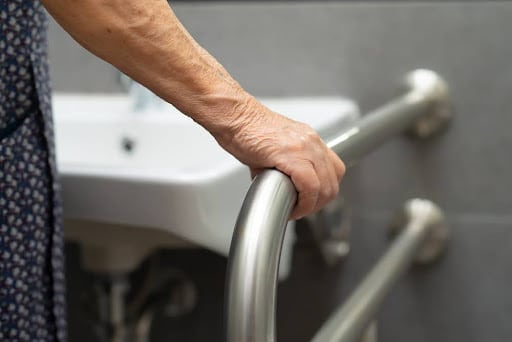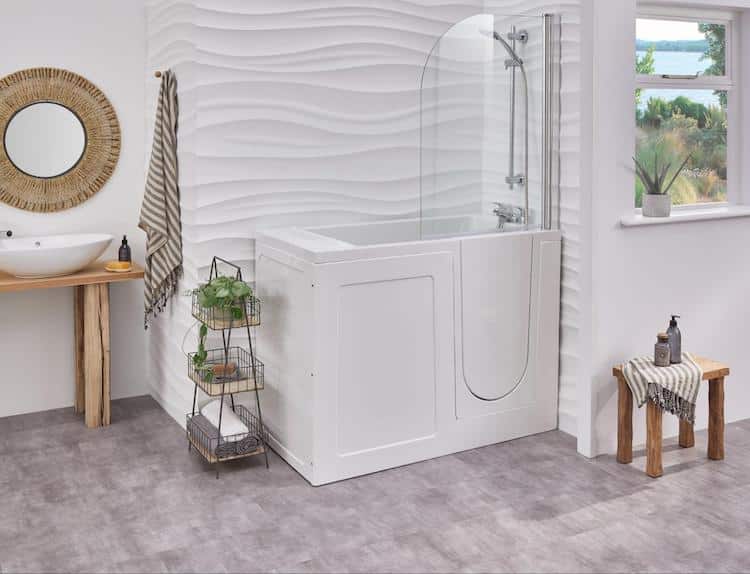Best Space Saving Bathtubs for a Small Mobility Bathroom
Transforming a small bathroom into a mobility bathroom with a bath involves clever design and the right type of bath. If you enjoy taking baths but have limited space, there are a wide range of space saving bathtubs to choose from. Maximising available floor space in a mobility bathroom is especially important for accessibility to ensure there is enough room to move around the toilet, sink and bath when using a walker, wheelchair or walking aids.
In this post, we will provide you with the low down on different styles and shapes, as well as the benefits of the various types of space saving bathtubs for older people or those with limited mobility.
Types of Space Saving Accessible Bathtubs
There are various shapes and styles of space saving accessible bathtubs; the most popular include:
- Corner: Corner baths can be an excellent option in a smaller mobility bathroom. Walk-in corner baths come with a door that makes it easy to enter and exit if you have limited mobility and will generally include a built-in seat.
- Alcove: Also referred to as built-in baths, they tend to be rectangular in shape and are fitted up against a wall. This is a popular choice for a walk-in bath where space is limited. Wheelchair users may find this bath style with a rising seat the easiest to get in and out of independently.
- Compact: A compact walk-in bath is a great option if floor space doesn’t allow for a full-length bath. They tend to be fitted against a wall but can also be free-standing. The door can be either on the side or at the end of a compact bath. And they tend to measure around 1.5 metres. Although there isn’t an official “standard,” 1.7 metres is commonly accepted as the standard bath size length in the UK, so these are a little smaller.
- Upright: An upright walk-in bath takes up the smallest amount of floor space, as they tend to measure approximately 1.2 metres. With a wide choice of styles and door options, they can be fitted or free-standing. Offering many health benefits, this type of bath is becoming more popular, especially for small bathrooms or ensuites.
What Are Low Baths?
Low bathtubs, also called shallow baths, are an excellent choice for those with restricted mobility who want their small bathroom to feel larger. They often feature strategically positioned safety handholds and can be stepped into easily. The handrails provide extra assistance when getting in and out of the bathtub, encouraging self-assurance and autonomy.
Low baths can be compact or standard length, as well as built-in or free-standing. In addition to being easier to enter and exit, low baths have the added benefit of using less water, making them more economical for everyday bathing.
What Are Upright Bathtubs?
Upright bathtubs, also known as tub baths, are the smallest sort of space saving bathtubs and provide a sleek, contemporary look for small accessible bathrooms. They are also perfect for an ensuite bathroom.
Larger mobility bathrooms can also benefit from an upright bath. Using less floor space with this type of bath can free up floor space for a separate walk-in shower or double vanity, for example, and will increase the room available around the toilet.
5 Health Benefits of Walk-in Upright Baths
In case you struggle with balance and find it challenging to enter and exit a standard bath, our walk-in, upright baths, when combined with a door, upright tubs are one of the most practical options for older people or those with disabilities. The effects of bathing have been extensively researched, and it has been shown to have physical and mental health benefits. Spending time in a bath immersed in water has been shown to promote:
1. Stress: Warm water immersion bathing in an upright bathtub has benefits beyond relaxation. Research into hydrotherapy combined with head-out water immersion of your body has been shown to increase dopamine levels and reduce cortisone (stress hormone) levels, which aid in mood regulation.
2. Heart function and blood flow: By widening blood vessels and enhancing circulation, a hot water immersion provides your body with automated cardiac activity. This accelerates healing and aids in the removal of toxins from the body.
3. Joint pain: Increasing the time spent in frequent baths with hot water could prove incredibly beneficial if you suffer from arthritis or persistent back and joint discomfort. Sitting upright reduces the physical exertion required to sit and stand and is often more comfortable. As your total body is submerged, this may be more effective at relieving muscle stiffness and tension.
Additional health benefits of upright baths are:
4. Self-esteem: The walk-in taller “tub” shape means you can take pleasure in bathing without assistance while remaining safely seated. Being able to take care of personal hygiene can also boost self-esteem and independence.
5. Skin health: The skin becomes increasingly fragile as we age, making it more prone to injury. If you don’t regularly wash, grime, perspiration, oil, and dead skin cells will start to build up, facilitating the growth of bacteria. Poor personal hygiene, skin infections and disorders can lead to serious conditions which may become harder to treat and more difficult to reverse.
Mobility Bathroom Aids and Safety Features
The incorporation of mobility aids and safety equipment in a mobility bathroom is an important part of the design for someone with mobility limitations or a wheelchair user. Depending on your unique needs and mobility limitations, consider including the following to increase independence when using the shower, bath or toilet:
- Assistance poles
- Grab rails
- Anti-slip flooring.

How to Choose a Bath for a Small Mobility Bathroom
Space saving bathtubs can significantly improve ease of movement for someone with limited mobility or who requires a wheelchair in a small bathroom. Before deciding on the type of bath that will work best for your needs, it may be helpful to consider the following:
- Bathroom dimensions and available floor space after accounting for the position of the toilet, sink and any safety features.
- Potential degeneration of mobility due to disability or illness.
- Do you need a bath, or would a shower-only mobility wetroom make better use of the space?
Why Select Age Care Bathrooms to Install a Small Mobility Bathroom?
We are happy to have installed walk-in baths and complete mobility bathrooms for hundreds of clients with small bathrooms or limited available space. Thanks to the expertise of our personable UK-based team, we can provide a full service from an initial 3D digital design and free home survey through to complete installation.
Since we value every one of our clients like family, we are upfront and honest. When we claim a fully equipped, top-quality walk-in bath starts at just £6,000, we mean it. On the day that your new walk-in bath is installed, we won’t ever try to upsell you anything, and there are no hidden fees. That’s just the Age Care way.
For more than 30 years, Age Care Bathrooms have been designing and installing mobility bathrooms.
If you would like to discuss your requirements for a small mobility bathroom or wet room, give our UK experts a call or request a free home survey.












